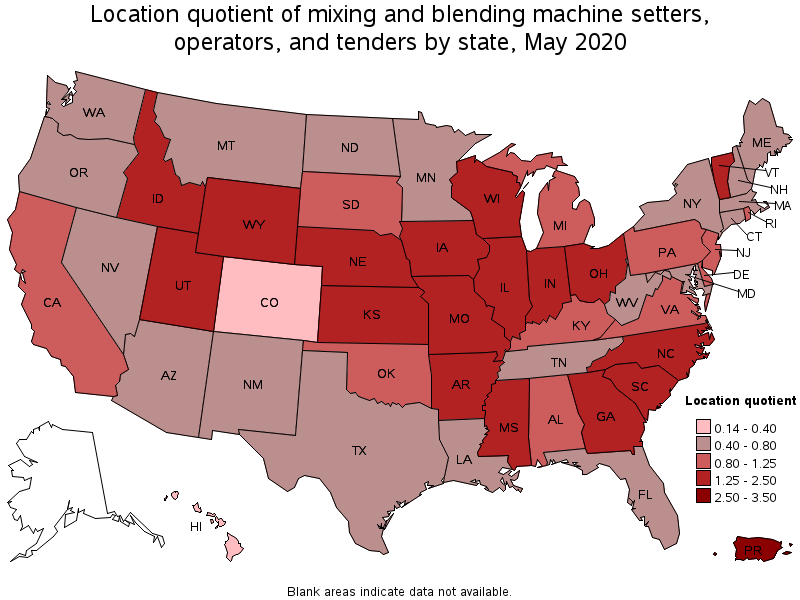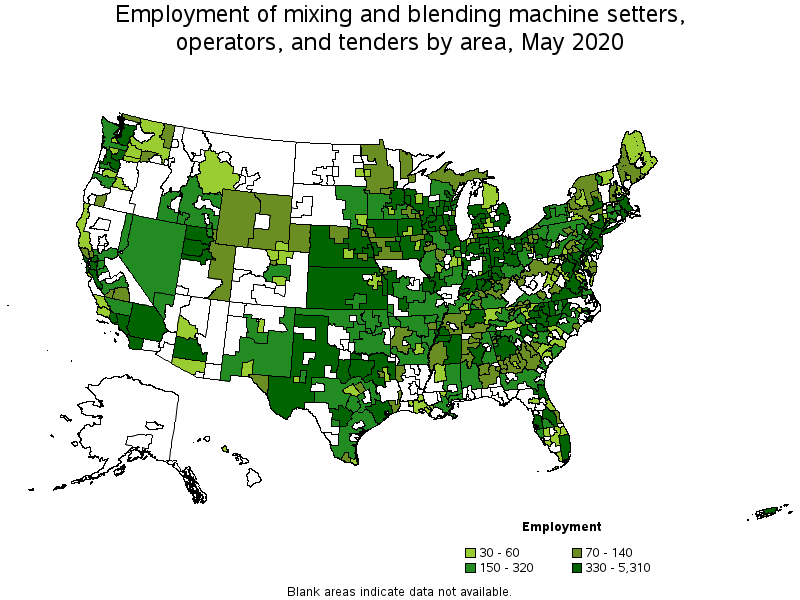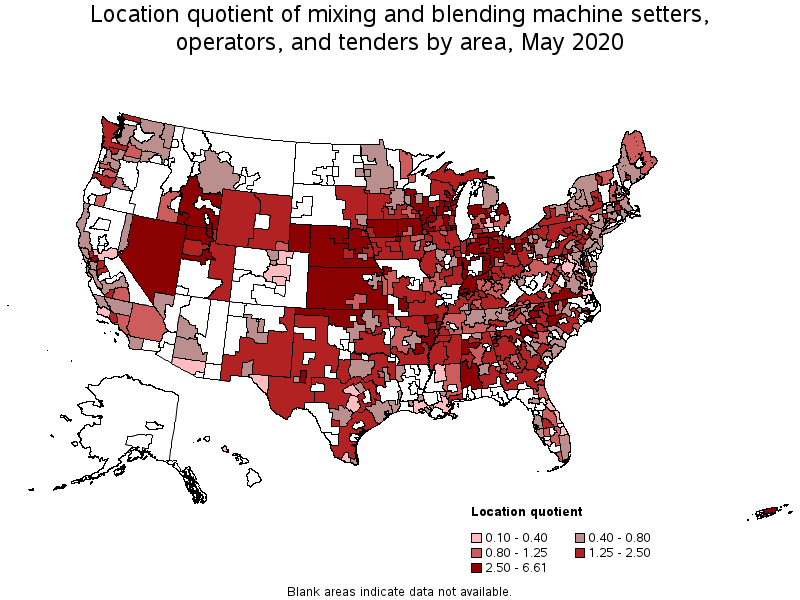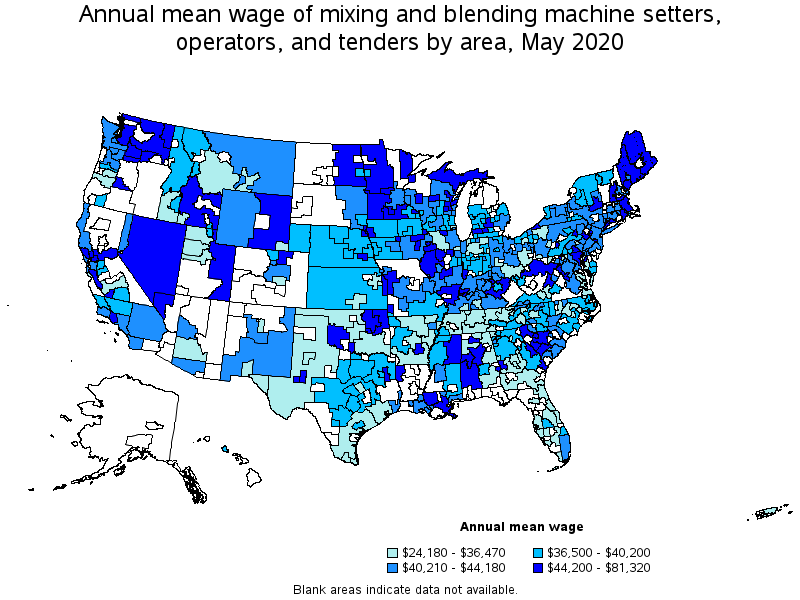An official website of the United States government
 United States Department of Labor
United States Department of Labor
Set up, operate, or tend machines to mix or blend materials, such as chemicals, tobacco, liquids, color pigments, or explosive ingredients. Excludes "Food Batchmakers" (51-3092).
Employment estimate and mean wage estimates for Mixing and Blending Machine Setters, Operators, and Tenders:
| Employment (1) | Employment RSE (3) |
Mean hourly wage |
Mean annual wage (2) |
Wage RSE (3) |
|---|---|---|---|---|
| 116,190 | 2.4 % | $ 19.69 | $ 40,960 | 0.5 % |
Percentile wage estimates for Mixing and Blending Machine Setters, Operators, and Tenders:
| Percentile | 10% | 25% | 50% (Median) |
75% | 90% |
|---|---|---|---|---|---|
| Hourly Wage | $ 12.85 | $ 15.17 | $ 18.60 | $ 23.47 | $ 28.84 |
| Annual Wage (2) | $ 26,720 | $ 31,550 | $ 38,690 | $ 48,820 | $ 60,000 |
Industries with the highest published employment and wages for Mixing and Blending Machine Setters, Operators, and Tenders are provided. For a list of all industries with employment in Mixing and Blending Machine Setters, Operators, and Tenders, see the Create Customized Tables function.
Industries with the highest levels of employment in Mixing and Blending Machine Setters, Operators, and Tenders:
| Industry | Employment (1) | Percent of industry employment | Hourly mean wage | Annual mean wage (2) |
|---|---|---|---|---|
| Chemical Manufacturing (3255 and 3256 only) | 16,980 | 9.94 | $ 19.18 | $ 39,890 |
| Chemical Manufacturing (3251, 3252, 3253, and 3259 only) | 14,660 | 4.08 | $ 20.59 | $ 42,830 |
| Nonmetallic Mineral Product Manufacturing | 11,230 | 2.80 | $ 20.80 | $ 43,270 |
| Pharmaceutical and Medicine Manufacturing | 10,220 | 3.43 | $ 19.46 | $ 40,470 |
| Animal Food Manufacturing | 7,630 | 11.81 | $ 18.17 | $ 37,790 |
Industries with the highest concentration of employment in Mixing and Blending Machine Setters, Operators, and Tenders:
| Industry | Employment (1) | Percent of industry employment | Hourly mean wage | Annual mean wage (2) |
|---|---|---|---|---|
| Animal Food Manufacturing | 7,630 | 11.81 | $ 18.17 | $ 37,790 |
| Chemical Manufacturing (3255 and 3256 only) | 16,980 | 9.94 | $ 19.18 | $ 39,890 |
| Chemical Manufacturing (3251, 3252, 3253, and 3259 only) | 14,660 | 4.08 | $ 20.59 | $ 42,830 |
| Pharmaceutical and Medicine Manufacturing | 10,220 | 3.43 | $ 19.46 | $ 40,470 |
| Petroleum and Coal Products Manufacturing | 3,440 | 3.16 | $ 22.53 | $ 46,860 |
Top paying industries for Mixing and Blending Machine Setters, Operators, and Tenders:
| Industry | Employment (1) | Percent of industry employment | Hourly mean wage | Annual mean wage (2) |
|---|---|---|---|---|
| Aerospace Product and Parts Manufacturing | 160 | 0.03 | $ 28.42 | $ 59,110 |
| Architectural, Engineering, and Related Services | 120 | 0.01 | $ 27.29 | $ 56,760 |
| Pulp, Paper, and Paperboard Mills | 1,600 | 1.74 | $ 25.16 | $ 52,330 |
| Iron and Steel Mills and Ferroalloy Manufacturing | (8) | (8) | $ 24.96 | $ 51,920 |
| Scientific Research and Development Services | 350 | 0.05 | $ 23.52 | $ 48,910 |
States and areas with the highest published employment, location quotients, and wages for Mixing and Blending Machine Setters, Operators, and Tenders are provided. For a list of all areas with employment in Mixing and Blending Machine Setters, Operators, and Tenders, see the Create Customized Tables function.

States with the highest employment level in Mixing and Blending Machine Setters, Operators, and Tenders:
| State | Employment (1) | Employment per thousand jobs | Location quotient (9) | Hourly mean wage | Annual mean wage (2) |
|---|---|---|---|---|---|
| California | 11,420 | 0.70 | 0.83 | $ 20.19 | $ 41,990 |
| Ohio | 7,400 | 1.44 | 1.73 | $ 19.46 | $ 40,480 |
| Illinois | 6,670 | 1.19 | 1.42 | $ 21.17 | $ 44,040 |
| Texas | 6,440 | 0.53 | 0.64 | $ 17.94 | $ 37,320 |
| North Carolina | 6,120 | 1.43 | 1.71 | $ 18.36 | $ 38,190 |

States with the highest concentration of jobs and location quotients in Mixing and Blending Machine Setters, Operators, and Tenders:
| State | Employment (1) | Employment per thousand jobs | Location quotient (9) | Hourly mean wage | Annual mean wage (2) |
|---|---|---|---|---|---|
| Wisconsin | 5,570 | 2.05 | 2.46 | $ 20.33 | $ 42,280 |
| Utah | 2,830 | 1.90 | 2.27 | $ 17.35 | $ 36,090 |
| Iowa | 2,720 | 1.85 | 2.21 | $ 20.11 | $ 41,830 |
| Indiana | 5,370 | 1.84 | 2.20 | $ 19.17 | $ 39,870 |
| Nebraska | 1,590 | 1.69 | 2.02 | $ 18.48 | $ 38,430 |

Top paying states for Mixing and Blending Machine Setters, Operators, and Tenders:
| State | Employment (1) | Employment per thousand jobs | Location quotient (9) | Hourly mean wage | Annual mean wage (2) |
|---|---|---|---|---|---|
| Louisiana | 1,010 | 0.56 | 0.67 | $ 26.71 | $ 55,550 |
| Maine | 280 | 0.48 | 0.58 | $ 24.77 | $ 51,530 |
| Rhode Island | 320 | 0.71 | 0.85 | $ 23.10 | $ 48,050 |
| Washington | 1,700 | 0.53 | 0.64 | $ 22.92 | $ 47,670 |
| Nevada | 720 | 0.58 | 0.69 | $ 22.77 | $ 47,370 |

Metropolitan areas with the highest employment level in Mixing and Blending Machine Setters, Operators, and Tenders:
| Metropolitan area | Employment (1) | Employment per thousand jobs | Location quotient (9) | Hourly mean wage | Annual mean wage (2) |
|---|---|---|---|---|---|
| Los Angeles-Long Beach-Anaheim, CA | 5,310 | 0.91 | 1.09 | $ 19.75 | $ 41,070 |
| Chicago-Naperville-Elgin, IL-IN-WI | 5,300 | 1.21 | 1.45 | $ 21.16 | $ 44,020 |
| New York-Newark-Jersey City, NY-NJ-PA | 4,890 | 0.55 | 0.66 | $ 20.33 | $ 42,300 |
| Atlanta-Sandy Springs-Roswell, GA | 2,940 | 1.12 | 1.34 | $ 18.91 | $ 39,340 |
| Charlotte-Concord-Gastonia, NC-SC | 1,970 | 1.63 | 1.95 | $ 19.32 | $ 40,170 |
| Dallas-Fort Worth-Arlington, TX | 1,660 | 0.46 | 0.55 | $ 17.77 | $ 36,960 |
| Cincinnati, OH-KY-IN | 1,530 | 1.48 | 1.78 | $ 20.37 | $ 42,370 |
| Houston-The Woodlands-Sugar Land, TX | 1,460 | 0.49 | 0.59 | $ 17.53 | $ 36,470 |
| Cleveland-Elyria, OH | 1,380 | 1.40 | 1.68 | $ 19.15 | $ 39,830 |
| Columbus, OH | 1,290 | 1.26 | 1.51 | $ 21.19 | $ 44,080 |

Metropolitan areas with the highest concentration of jobs and location quotients in Mixing and Blending Machine Setters, Operators, and Tenders:
| Metropolitan area | Employment (1) | Employment per thousand jobs | Location quotient (9) | Hourly mean wage | Annual mean wage (2) |
|---|---|---|---|---|---|
| Dalton, GA | 330 | 5.52 | 6.61 | $ 17.60 | $ 36,610 |
| Twin Falls, ID | 230 | 5.09 | 6.10 | $ 16.09 | $ 33,460 |
| Racine, WI | 360 | 4.99 | 5.98 | $ 17.03 | $ 35,430 |
| Appleton, WI | 470 | 4.06 | 4.86 | $ 23.15 | $ 48,160 |
| Logan, UT-ID | 220 | 3.81 | 4.57 | $ 18.72 | $ 38,940 |
| Ames, IA | 160 | 3.72 | 4.45 | $ 22.44 | $ 46,670 |
| Oshkosh-Neenah, WI | 330 | 3.64 | 4.36 | $ 22.08 | $ 45,940 |
| Provo-Orem, UT | 820 | 3.25 | 3.89 | $ 16.44 | $ 34,200 |
| Evansville, IN-KY | 460 | 3.13 | 3.75 | $ 21.85 | $ 45,440 |
| Hickory-Lenoir-Morganton, NC | 450 | 3.13 | 3.75 | $ 15.91 | $ 33,090 |

Top paying metropolitan areas for Mixing and Blending Machine Setters, Operators, and Tenders:
| Metropolitan area | Employment (1) | Employment per thousand jobs | Location quotient (9) | Hourly mean wage | Annual mean wage (2) |
|---|---|---|---|---|---|
| Shreveport-Bossier City, LA | 100 | 0.61 | 0.73 | $ 31.20 | $ 64,900 |
| Rockford, IL | 130 | 0.98 | 1.17 | $ 26.62 | $ 55,380 |
| Pine Bluff, AR | 60 | 2.30 | 2.76 | $ 26.60 | $ 55,330 |
| Greeley, CO | 30 | 0.31 | 0.37 | $ 25.81 | $ 53,690 |
| Portland-South Portland, ME | (8) | (8) | (8) | $ 25.09 | $ 52,190 |
| Peoria, IL | 70 | 0.45 | 0.53 | $ 24.99 | $ 51,980 |
| Seattle-Tacoma-Bellevue, WA | 850 | 0.43 | 0.52 | $ 24.58 | $ 51,140 |
| Wausau, WI | (8) | (8) | (8) | $ 24.31 | $ 50,570 |
| Battle Creek, MI | 30 | 0.71 | 0.85 | $ 24.26 | $ 50,460 |
| Yakima, WA | 60 | 0.69 | 0.83 | $ 23.85 | $ 49,610 |
Nonmetropolitan areas with the highest employment in Mixing and Blending Machine Setters, Operators, and Tenders:
| Nonmetropolitan area | Employment (1) | Employment per thousand jobs | Location quotient (9) | Hourly mean wage | Annual mean wage (2) |
|---|---|---|---|---|---|
| Kansas nonmetropolitan area | 920 | 2.43 | 2.91 | $ 18.38 | $ 38,240 |
| North Northeastern Ohio nonmetropolitan area (noncontiguous) | 840 | 2.70 | 3.24 | $ 20.21 | $ 42,040 |
| Piedmont North Carolina nonmetropolitan area | 660 | 2.68 | 3.21 | $ 20.15 | $ 41,920 |
| Balance of Lower Peninsula of Michigan nonmetropolitan area | 560 | 2.29 | 2.74 | $ 18.95 | $ 39,420 |
| West Northwestern Ohio nonmetropolitan area | 540 | 2.26 | 2.71 | $ 19.75 | $ 41,080 |
Nonmetropolitan areas with the highest concentration of jobs and location quotients in Mixing and Blending Machine Setters, Operators, and Tenders:
| Nonmetropolitan area | Employment (1) | Employment per thousand jobs | Location quotient (9) | Hourly mean wage | Annual mean wage (2) |
|---|---|---|---|---|---|
| Northeast Iowa nonmetropolitan area | 460 | 4.70 | 5.62 | $ 18.99 | $ 39,500 |
| Northeast Nebraska nonmetropolitan area | 350 | 3.89 | 4.66 | $ 18.19 | $ 37,840 |
| Western Wisconsin nonmetropolitan area | 510 | 3.86 | 4.63 | $ 20.35 | $ 42,330 |
| Southeast-Central Idaho nonmetropolitan area | 310 | 3.72 | 4.45 | $ 22.53 | $ 46,860 |
| Southside Virginia nonmetropolitan area | 340 | 3.46 | 4.14 | (8) | (8) |
Top paying nonmetropolitan areas for Mixing and Blending Machine Setters, Operators, and Tenders:
| Nonmetropolitan area | Employment (1) | Employment per thousand jobs | Location quotient (9) | Hourly mean wage | Annual mean wage (2) |
|---|---|---|---|---|---|
| Eastern Utah nonmetropolitan area | 90 | 1.15 | 1.37 | $ 39.10 | $ 81,320 |
| Southwest Maine nonmetropolitan area | 90 | 0.51 | 0.61 | $ 28.18 | $ 58,610 |
| Southwest Alabama nonmetropolitan area | 170 | 2.57 | 3.07 | $ 27.30 | $ 56,790 |
| Northwest Virginia nonmetropolitan area | 60 | 0.92 | 1.11 | $ 24.41 | $ 50,770 |
| Nevada nonmetropolitan area | 250 | 2.75 | 3.29 | $ 24.27 | $ 50,480 |
These estimates are calculated with data collected from employers in all industry sectors, all metropolitan and nonmetropolitan areas, and all states and the District of Columbia. The top employment and wage figures are provided above. The complete list is available in the downloadable XLS files.
The percentile wage estimate is the value of a wage below which a certain percent of workers fall. The median wage is the 50th percentile wage estimate—50 percent of workers earn less than the median and 50 percent of workers earn more than the median. More about percentile wages.
(1) Estimates for detailed occupations do not sum to the totals because the totals include occupations not shown separately. Estimates do not include self-employed workers.
(2) Annual wages have been calculated by multiplying the hourly mean wage by a "year-round, full-time" hours figure of 2,080 hours; for those occupations where there is not an hourly wage published, the annual wage has been directly calculated from the reported survey data.
(3) The relative standard error (RSE) is a measure of the reliability of a survey statistic. The smaller the relative standard error, the more precise the estimate.
(8) Estimate not released.
(9) The location quotient is the ratio of the area concentration of occupational employment to the national average concentration. A location quotient greater than one indicates the occupation has a higher share of employment than average, and a location quotient less than one indicates the occupation is less prevalent in the area than average.
Other OEWS estimates and related information:
May 2020 National Occupational Employment and Wage Estimates
May 2020 State Occupational Employment and Wage Estimates
May 2020 Metropolitan and Nonmetropolitan Area Occupational Employment and Wage Estimates
May 2020 National Industry-Specific Occupational Employment and Wage Estimates
Last Modified Date: March 31, 2021